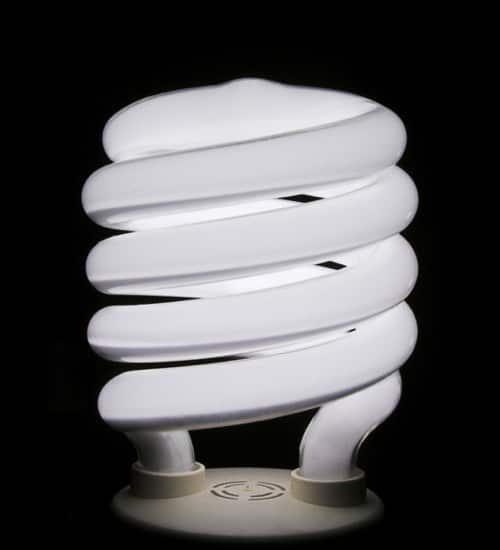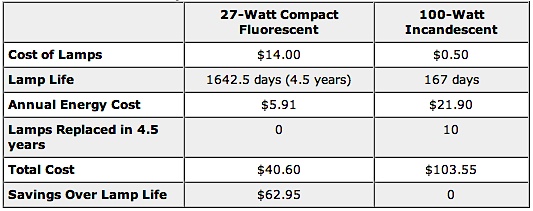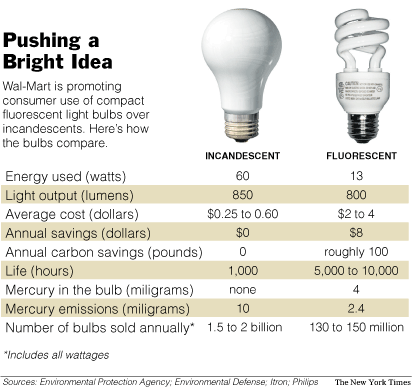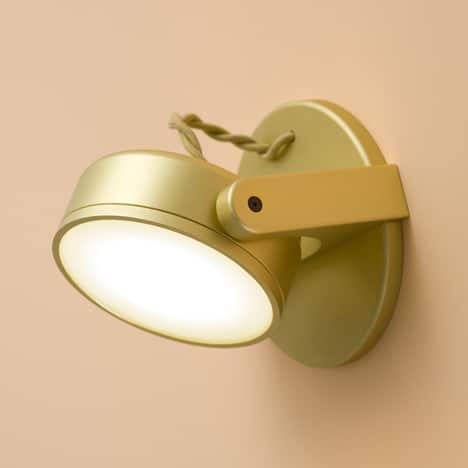
I’ve been collecting information about CFLs for a few months now, and I’ve kept from writing this post for some reason until now. There is so much back and forth out there about compact fluorescents versus incandescents, compact fluorescents versus using halogens at a lower intensity via a dimmer, and the economy versus compact fluorescents.
There is a fact of life that impacts the sale of CFLs right now – Americans, as well as people all over the world, are freaking broke. A dollar difference in a loaf of bread or a gallon of milk is a big deal when everything else is costing more. We’re in a crapstorm, and when you’re dealing with a 3-4 times price increase between incandescent lamps and CFLs, what do you think people are going to buy? Most people are not versed in looking towards the long-term benefits of anything; a good example is the fact that McDonalds is experiencing record growth and profits in this economic downturn. Hmm.
There are some major factors that play into compact fluroescent market share – cost vs. cost savings, output quality, manufacturing quality, application, and yes, aesthetic preference.
Maybe it’s easiest to start out with the most subjective issue – aesthetic choice, and how most people feel about the light emitted by CFLs. It’s not hard to find pretty harsh criticism on compact fluorescent lamps, all you have to do is look nearly any review of the matter. A lot of people do not like the quality of light that comes from compact fluorescent sources. Sometimes this is an understatement – some people downright hate CFL light. A New York Times article on the subject of CFLs versus incandescents had some people quoted on their feelings towards CFLs:
My experience with the new bulbs has been dismal. The quality of the light is bad until they warm up. They cost 3 to 5 times as much as an incandescent, and if you have old-fashioned energy-saving habits like turning off the lights when you leave the room, they don’t last any longer than the tungsten bulbs (sometimes less). And they’re more difficult to dispose of properly because of the toxic content. Maybe L.E.D. lights will be better if the price can become reasonable.
And:
There’s a difference between a low-flow toilet (which, if it performs properly, shouldn’t be an obvious change) and light bulbs that make your entire family look like cadavers.
And my personal favorite, leaving my opinion out of it altogether:
The amount of whining and the unwillingness to make small sacrifices of aesthetic preference in order to support an effort to save the habitability of our planet is disgusting. No wonder this country is such a mess.
At least we know how people really feel – and it’s not hard to see what people mean about looking like corpses. The fluorescent lighting does have a tendency to make people look pretty crappy. I’m a lighting designer, so light quality is something that gets a lot of attention in our home. However, we do use a lot of CFLs in our home, too – the cost savings do add up. We use a compact fluorescent anywhere that is what we consider a “medium-use space” – the laundry room, the back porch, the front porch, the garage, and in lamps that get turned on infrequently – like the one in the room with our television and video games. However, I use incandescents in the kitchen and in the dining room. The kitchen gets a lot of use, but the dining room does not. I just like to make the food I prepare look good. Could I do this with a CFL, or a few CFLs? Sure. But I have some incandescents I like for their color temperature, light output, and quality, and they are four of very few incandescents still in the house.
Now to be fair, there are “cool white” and “warm white” CFLs. As a a matter of fact, most CFLs have both the lumens and the color temperature stamped on the package somewhere, in most cases. There are certainly some cheapos that are in packaging with as little info as possible, and these are usually pretty crappy quality CFLs. It’s also a fact that a large portion of the population could give a damn about what any of those numbers on the box mean – as long as it screws in, turns on, and doesn’t burn out this month, they’re happy. Buying the right color temperature for the right application and feel is a principle that is not lost on those of us who know light and its idiosyncrasies. However, this is lost on most people. Buying cold CFLs and putting them in the living room might just make your whole family look like dead people. It’s not a terribly difficult to understand concept – incandescents (generally) are warm, towards the amber end of the color spectrum – like a face flushed from the first Scotch of the evening. Compact fluorescents generally sit on the blue end of the spectrum, high color temperature, and seem to take the blood out of a person’s face.
The interesting aspect of the aesthetic argument is that tests have been done that suggest that people on average cannot tell the difference with modern CFLs and incandescents unless they see the actual lamp.
Looking at cost, CFLs range between about $1.75 and $5 each – and incandescent sources (except maybe the Reveal lamp) being around 25 cents at the cheapest and a dollar at the most. Operating costs are just as dramatic of a difference, with an average of 70% savings over incandescents. It’s hard for people to see this long term, but look at some numbers:


There are efforts to ban the incandescent lamp all over the world. I realize this is just to force the population to exhibit a little energy savings, but I personally hate the thought of not having incandescent sources at my disposal as a lighting designer. I am all for energy savings and being good to Mother Earth. However, there are certain applications where we just don’t have a comparable quality source. This is a fact. Companies are working on it, so we’ll see how that goes.
Manufacturing quality of CFLs is like anything else manufactured – there are some superior brands and types and some very, very bad brands and types. Some have a lot of mercury, some have little mercury. There are also a lot – a lot – of Energy Star rated CFLs that actually do not meet the standards. A lot of CFLs failed 2008 standards – there are more than 3,000 CFLs that meet the 2003 Energy Star standards, but 1,100 of these lamps fail the 2008 standard. It might also be noteworthy that the Department of Energy has given a grace period until July 1, 2009 for those companies whose products failed the 2008 standards to sell about 100 million lamps that haven’t sold because of the economy. It might also be due to the poor quality of some of them, too. But that’s just a guess. A company called the Environmental Working Group has published this ridiculously long list of FAIL lamps. The report from EWG lists CFLs that are stamped with the Energy Star logo, but failed 2008 standards. How do you like that? 167 brands, give or take, failed.
I’d check out that list. You’ll be surprised who is on it.
Now on the other side, there are CFLs who have a low mercury content and a high longevity. Treehugger posted a “cream of the crop” list of CFLs:
- Earthmate’s Mini-size bulbs-13, 15, 20 and 25 Watt
- Litetronic’s Neolite-10, 15, 20, 23 Watt
- Sylvania Micro-Mini-13, 20 and 23 Watt
- Sylvania DURA-ONE-reflector bulbs
- Feit EcoBulb
- MaxLite
- Philips with Alto lamp technology
Energy Star has a standard equivalent wattage chart:

One of the big contentions of CFL haters is the mercury issue. Mercury is a poison. Mercury poisoning doesn’t sound like anything I want to take part in at all, nor do I want anyone else to have it. I’ve read stories about a woman breaking a CFL in her home and acquiring a $2000 clean up bill. Why that happened, I do not know – but clean up experts say that hazard removal services aren’t required for breaking a lamp in your house. I wouldn’t be freebasing the broken lamp or sucking on the broken tube, but you probably don’t need five guys in full hazmat gear trapsing through your house, either.
There are some guidelines for cleaning up a broken CFL. You should take a few precautions, you know, to be safe. Most of these are common sense:
- get children and your newborn baby out of the immediate area of the broken lamp.
- air out the room for 5-10 minutes, if possible.
- put on some gloves and a mask to clean up the broken lamp.
- put the pieces in a glass jar of plastic container, and seal it all up.
- wipe up the floor and clean your hands and such.
- recycle, don’t throw away, the busted CFL.
Seems pretty painless, maybe inonvenient. It is a pain to dispose of CFLs, but don’t toss them in the garbage. Take a few moments, find the recycling program for CFLs near you, and take them there. If you don’t have time to take them there, seal them up in the garage or other out-of-the-way place and wait until you can.
Nothing is without its negative aspects. Take tiramisu for example. Delicious, but it makes my ass big.
Thanks to the EWG, Treehugger, EcoGeek, and NYT!





Great post…I am not in the lighting business, but I am obsessed with perfect lighting in placement, delivery and quality. I just moved into a house full of recessed halogens and the light quality is great…at a $100 monthly electric bill. I replaced lights in one bedroom with CFL’s just to see if I could stomach the light, and I changed them back. It was awful.
Is ANYONE making an even marginal CFL with a halogen-like quality?
Everybody that cares for their familiy & friends OR notices the pain and headaches they get from the bulbs can now understand more thanks to a investigative news show from Canada called 16 by 9. (Sort of like USA’s 20/20 program on ABC) They did an episode called “Rays or Rash” 4+ parts. I appreciate finding it and wanted to pass it on to you lighting enthusiast.. You can search for it on youtube.com http://www.youtube.com/watch?v=6CVLa_tRslY
* I have personally noticed headaches from these CFL bulbs and searched & found many others have the same side effects.
From the program:
What is dirty electricity or electrical pollution?
Electrical pollution refers to low frequency electromagnetic waves that have unwanted effects, such as badly shielded electric cables that induce disturbances in electrical devices nearby.
Imagine turning on a light bulb and within 20 minutes you notice skin problems.
“When I looked in the mirror and saw my face I was absolutely horrified. I didn’t exactly know what had caused it or whether it could be controlled or whether it was short term or long term. So, I was just completely aghast.”
And there are others, who complain about getting dizzy, extremely arthritic, nagging pain and headaches.
When Jane Petiluck changed all her bulbs in the basement of her St. Catherines, Ontario home, a mysterious rash started to appear. Since then she has changed all the bulbs back to incandescent.
The first concern is what may be coming off from the bulbs. Ultraviolet Radiation. Scientists say the bulbs, give off UV. Like the sun gives off. We know this because Health Canada – they’re the people who make sure the products and drugs you use are safe – told us that in an email that “CFLs are not provided with a prismatic diffuser that filters ultraviolet radiation out. Therefore, there may be skin sensitivity issues, especially in people with certain skin diseases”
Health Canada is currently testing the bulbs to see if, and how much, radiation it gives off.
Comments are closed.